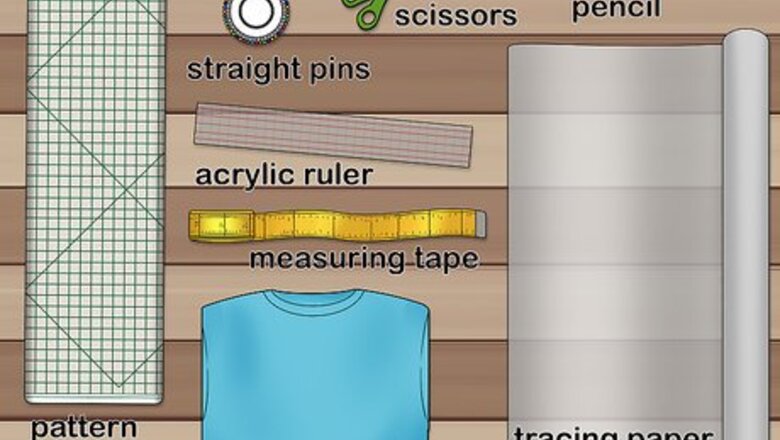
views
Looking to design or screen print your t-shirt instead? Jump to a step-by-step guide to that process here.
Making a Pattern
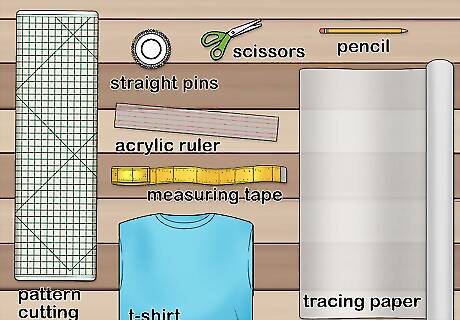
Gather your supplies. Making your own pattern requires some special supplies, most of which you can find online, or at your local craft store. If you plan on making a lot of clothes, consider investing in a cardboard Pattern Cutting Board. You can use any large piece of cardboard, but Pattern Cutting Boards have grid lines to make measuring easier. Acrylic rulers, also known as quilting rulers, are made especially for cutting fabric. You can buy rolls of tracing paper, or you can use medical exam table paper. Straight pins A pencil A cardboard Pattern Cutting Board, or large piece of cardboard An acrylic ruler Tracing paper A measuring tape Scissors A t-shirt

Lay out your paper. Give yourself plenty of room to work with, and unfold your cardboard. Cut a piece of tracing paper that is a little bigger than the t-shirt you'll be measuring and lay it on the cardboard.
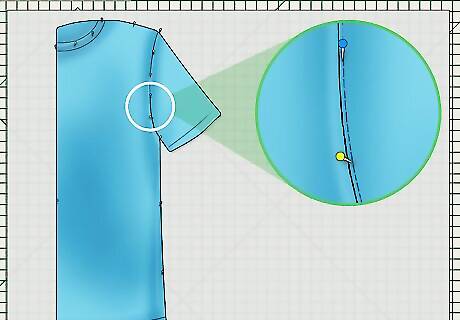
Pin your t-shirt to the board. Fold your t-shirt in half vertically, with the front half of the t-shirt on the outside. Lay the folded t-shirt on the paper and smooth it out. Use your straight pins to start pinning the seam lines. Keep the pins upright and push them into the cardboard. Use more pins along curved seam lines to get a more accurate measurement.

Remove the pins from the t-shirt. Once you've pinned all the way around the shirt, remove the pins and lift the shirt off the paper. You should be able to see the holes you made.
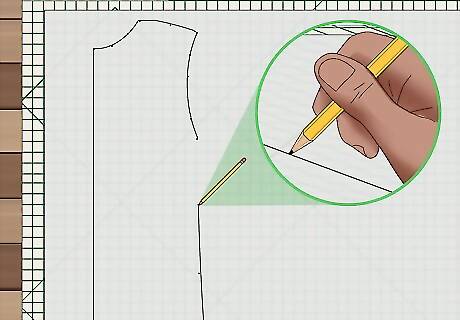
Trace your pattern. Mark the holes with your pencil so they're easier to see. Use your ruler to start connecting the dots until you've outlined the entire half of the t-shirt. After you've traced the entire shirt, go back through and round out the corners on the neckline and the armhole. When you've finished tracing your pattern, label it. Include the original garment type, the size, and which piece of the pattern it is. In this case, you measured the front of the shirt. Remember to mark the fold line of your pattern. Make a note to cut one on the fold.
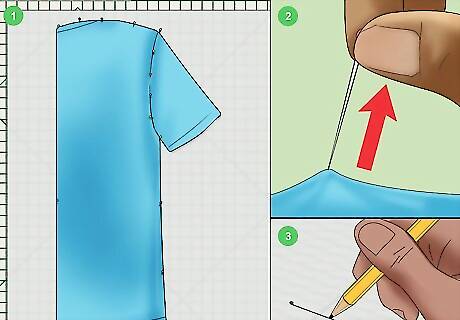
Repeat the pinning process for the back of the shirt. Fold the t-shirt in half, but this time make sure the back of the shirt is on the outside. Lay it on the tracing paper and pin the seams. Remember to mark the fold line and label this piece of the pattern as the back of the shirt. The neckline, armholes, and hemline on the back of the shirt may be a little different than the front. Try to pin accurately so you have good measurements.
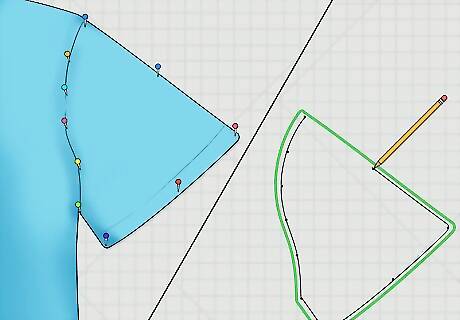
Pin the sleeves. Pinning the sleeves is a little different than pinning the front and back of the shirt. Flatten the sleeve on the paper and pin the seams. Keep the sleeve as flat as possible. Follow the same tracing process as you did with the front and back of the shirt. When you label the sleeve piece, make a note that you will need to cut two on the fold.
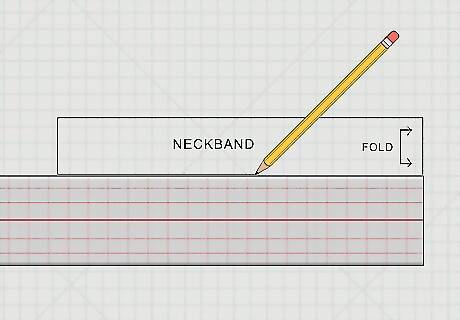
Make a neckband pattern. Turn your shirt inside out and match up the shoulders. Pin the four corners of the neckband. Place some pins in the center of the neckband as well. Use your ruler to make the neckband piece a rectangle. The neckband is folded in half, so make sure you double the width on your pattern piece. Subtract about an inch from the length of the pattern to account for the stretch of a neckband. Label the pattern piece accordingly, and make a note to cut one on the fold.
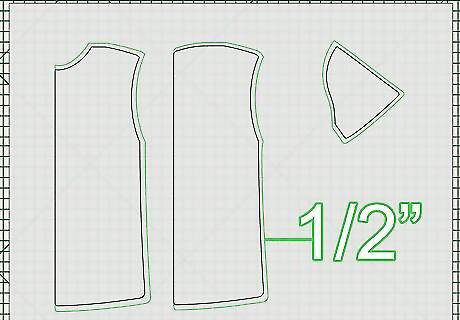
Add seam allowances to your pattern pieces. Use your ruler and go back through your pattern pieces and add about 1/2" seam allowance. Measure the hems on the sleeves and shirt bottom and add that amount to the corresponding pattern.
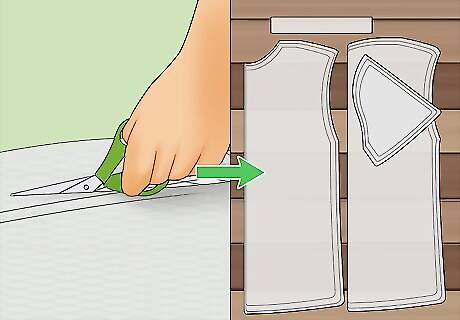
Cut your pattern out. Cut each piece out around the outer edge. Leave some space so that you are not cutting along the seam allowance lines. You should have a total of four pieces: one sleeve, one front, one back, and a neckband. Make sure each piece is properly labeled. You can store your pattern in a folder or a large envelope.
Cutting the Fabric
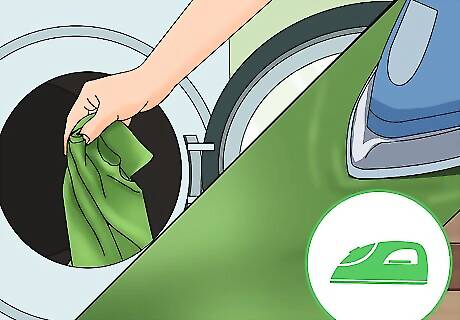
Prepare your fabric. It's a good idea to wash your fabric before you start sewing. Some fabrics will shrink when they're washed, resulting in a poor fit. Washing beforehand will prevent this. Think about what type of fabric you want to make your t-shirt from. Fabrics fall into two basic categories. There are knit fabrics and woven fabrics. Most shirts use a knit fabric, which is softer than woven fabric. Knit fabrics stretch easier than woven fabrics, making them a little more difficult to work with. However, the added stretch of knit makes for a more breathable garment. Press your fabric after you wash and dry it. You want the fabric to be as smooth as possible before you start working with it. If you're worried about your iron ruining your fabric, do a test press on a small scrap.
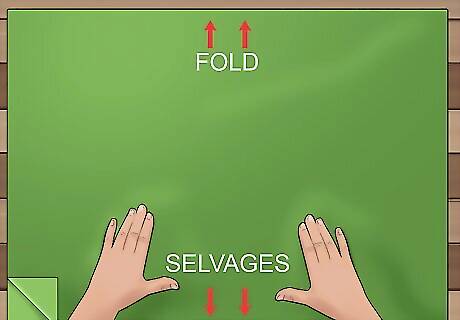
Lay out your fabric. Give yourself plenty of room to work. Try to work at a table rather than on the floor. You need a hard surface to make sure you get the fabric as smooth as you can. Cutting on a soft surface can also yield inaccurate cuts. Fold the fabric in half, making sure the selvages are together. Selvages are the woven edges of the fabric. Your fabric will have a "right side" and a "wrong side." The right side is the front of the fabric. It will be easier to tell the right side of the fabric if it has a pattern on it. When you fold your fabric, keep the right sides facing each other. Keep the fabric as smooth as possible when you lay it out.
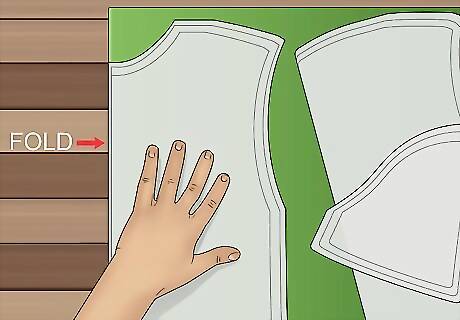
Arrange your pattern on the fabric. Take the pieces of your pattern and arrange them on your fabric according to your cutting instructions. Some pattern pieces will say "cut one on the fold," or "cut two on the fold." Line these pieces up along the fold of your fabric.

Pin your pattern pieces to the fabric. Use straight pins to pin your pattern pieces to your fabric before cutting. Pin the corners of your pattern first, and then pin along the edges. If you prefer, you can weigh the fabric and then use chalk to draw an outline on your fabric.
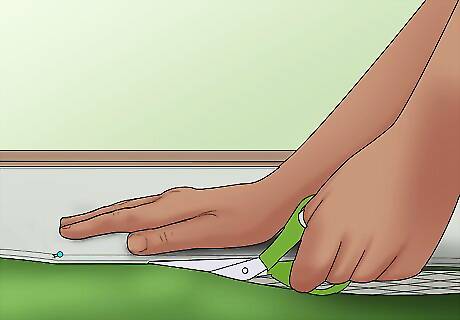
Cut your fabric. Hold the fabric down with one hand, and use your other hand to cut the fabric. Take your time cutting. Use long strokes, and keep the scissors at a 90-degree angle to your cutting surface.
Sewing Your Shirt
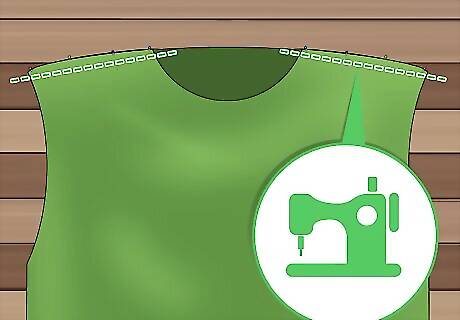
Sew the shoulders. Take the front and back pieces of your shirt line them up. Make sure the right sides are facing each other, and pin them together at the shoulders. Sew the shoulders together using a straight stitch on your sewing machine. When you're finished sewing the pieces together, iron out the seams.
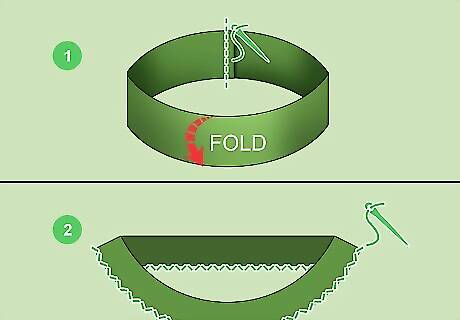
Make your neckband. Take the piece of fabric you cut for your neckband and sew the two short ends together using a straight stitch. Your neckband should now be a loop. Fold the neckband piece in half lengthwise with the wrong sides together. Pin the edges and sew them together using a narrow zig-zag stitch.

Pin the neckband to the shirt. Take your shirt and lay it open. Flatten the shoulders and pin the neckband to the neckline on the right side of the fabric. Pin the neckband at the shoulders first, and then the center and back. Once you've pinned the neckband at these four points, put one more pin between each point. You may have to stretch the neckband to get it to fit in the neckline. This is okay. You want the neckband to be smaller than the neckline so that you have a comfortable fit.

Sew the neckband. Use either a straight stretch stitch or a zig-zag stitch. You want a stitch that will stretch with the fabric. Sew one section at a time, stretching the fabric of the neckband as you go. As you finish a section, remove the pins and make sure the fabric of the shirt is not pleating beneath the neckband. When you finish sewing the neckband, go over it with an iron to press the seams.
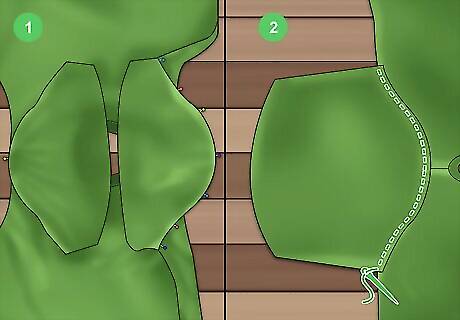
Stitch the sleeves. Lay the shirt out flat and pin the middle of the sleeve curve to the middle of the armhole. Keep the right sides of the fabric together. Pin the sleeve along each side of the armhole. Use a straight stitch to sew the sleeve onto the shirt. Repeat this process with the other sleeve. Once you have attached both sleeves to your shirt, iron the seams.

Sew the side seams. Keep the right sides of the fabric together and pin along the sides of the shirt. Pin the sleeve sides first and work your way down to the hemline. Use a straight stitch to sew the sides of the shirt together. Start at the end of the sleeve and work your way down the side of the shirt. Fold between 1/2" to 1" of fabric under the bottom edge of the shirt. Iron this fabric down and use either a straight or zigzag stitch to sew your hem. Press the hem once more when you have finished sewing.
Now cut out what you want on your shirt on paper. Color it. Then iron it on.

















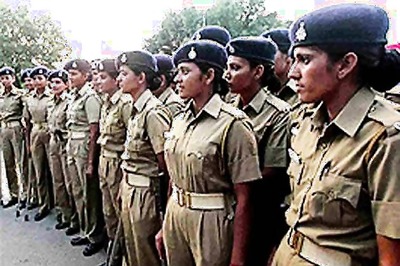

Comments
0 comment